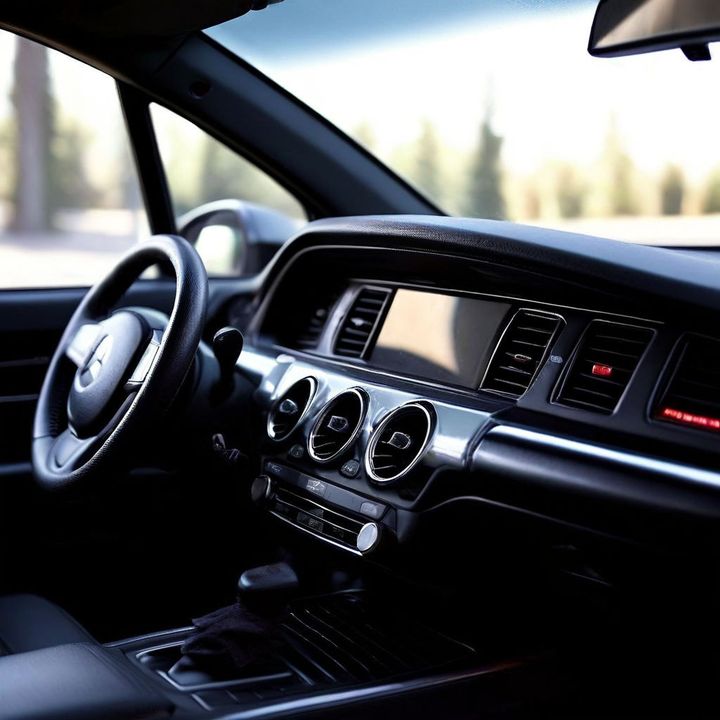


Having a properly functioning air conditioning (AC) system is crucial for maintaining a comfortable driving experience, especially during hot summer days. One common issue that many car owners face is when the AC is not blowing air from the front vents, which can be frustrating and inconvenient. This problem can arise due to various reasons, ranging from simple blockages to more complex mechanical or electrical failures.

Before we dive into the solutions, it's essential to understand the possible reasons why your car's AC isn't blowing air from the front vents. Here are some of the most common culprits:
| Potential Cause | Description |
|---|---|
| Clogged Cabin Air Filter | The cabin air filter is responsible for filtering out dust, pollen, and other airborne particles from the air entering your vehicle's cabin. When this filter becomes excessively clogged, it can restrict airflow to the vents, causing a lack of air circulation. |
| Blocked or Stuck Air Vents/Ducts | Over time, debris or objects can accumulate within the vent pathways or ducts, obstructing the flow of air. This blockage can prevent air from reaching the front vents, even if the AC system is functioning correctly. |
| Faulty Blend Door Actuator | The blend door actuator is a crucial component that controls the direction of airflow within your vehicle's HVAC (Heating, Ventilation, and Air Conditioning) system. If this actuator malfunctions or breaks, it can cause the air to be diverted away from the front vents, even if the system is producing cool air. |
| Vacuum Leaks | Many modern vehicles rely on vacuum lines and connections to operate various HVAC system components, including the blend door actuator. If there are leaks in these vacuum lines, it can cause the system to default to a defrost mode, diverting air away from the front vents and onto the windshield. |
| Low Refrigerant Levels | While low refrigerant levels may not directly cause a lack of airflow from the front vents, they can lead to a frozen evaporator core. When the evaporator core freezes over, it can restrict airflow, preventing cool air from reaching the vents. |
Before attempting any repairs, it's crucial to diagnose the root cause of the issue. Here are some troubleshooting steps you can take:
Check the Cabin Air Filter: Visually inspect the cabin air filter for clogs or excessive buildup of debris. If it appears heavily soiled, replace it with a new one.
Listen for Airflow Sounds: Turn on your AC system and listen carefully for any airflow sounds coming from the vents. If you don't hear any airflow, it could indicate a blockage or obstruction in the vent pathways.
Check Other Vents: Observe if air is blowing from other vents, such as the defrost or floor vents. If air is coming from these vents but not the front vents, it could point to a blend door actuator issue.
Inspect Vacuum Hoses and Connections: Carefully examine the vacuum hoses and connections for any cracks, disconnections, or leaks. These leaks can cause the system to default to defrost mode, diverting air away from the front vents.
Check Refrigerant Pressures: Use a manifold gauge set to check the refrigerant pressures in your AC system. Low refrigerant levels can indicate a leak, which may lead to a frozen evaporator core and restricted airflow.
Once you've identified the potential cause of the issue, it's time to address it. Here are some detailed repair instructions for common AC problems:
Locate the cabin air filter housing, which is typically behind the glovebox or under the dashboard. The location may vary depending on your vehicle's make and model, so consult your owner's manual or a repair guide for specific instructions.
Remove the housing cover or access panel, following the manufacturer's instructions. This may involve removing screws, clips, or other fasteners.
Carefully extract the old filter, taking note of its orientation and any additional components that may need to be removed or reinstalled.
Clean the housing area if necessary, using a vacuum cleaner or compressed air to remove any accumulated debris or contaminants.
Install a new cabin air filter according to the manufacturer's instructions, ensuring proper alignment and orientation.
Reassemble the housing cover or access panel, securing it in place with the appropriate fasteners.

Remove the vent covers or panels to access the duct pathways. This may involve removing screws, clips, or other fasteners, depending on your vehicle's design.
Use compressed air or a vacuum cleaner with a crevice tool to dislodge any debris obstructing the airflow within the ducts. Be careful not to damage the duct material or surrounding components.
Carefully inspect the ducts for any remaining obstructions and clear them as needed, using appropriate tools or methods recommended by the manufacturer.
Once the ducts are clear, reassemble the vent covers or panels, ensuring proper alignment and secure fastening.
| Step | Description |
|---|---|
| 1 | Remove the HVAC housing to access the blend door actuator. This may involve removing various panels, covers, or components, depending on your vehicle's design. Consult a repair manual or seek professional assistance if unsure. |
| 2 | Disconnect the actuator from its electrical and mechanical connections, taking note of the orientation and any additional components that may need to be removed or reinstalled. |
| 3 | Install the new actuator, ensuring proper alignment and connections. Follow the manufacturer's instructions carefully to avoid any potential issues. |
| 4 | Recalibrate or reset the HVAC system after the replacement, following the manufacturer's instructions. This step is crucial to ensure the new actuator functions correctly and the system operates as intended. |
| 5 | Reassemble the HVAC housing and any other components removed during the repair process, ensuring proper alignment and secure fastening. |
Inspect all vacuum hoses and connections for cracks, disconnections, or leaks. Pay close attention to areas where hoses may rub against other components or where connections may have loosened over time.
Replace any damaged or cracked vacuum hoses or components, following the manufacturer's recommendations for replacement parts and installation procedures.
Seal any leaks using approved vacuum hose sealants or repair kits, following the product instructions carefully.
After repairing the leaks, test the system to ensure proper operation and verify that no additional leaks are present.
Use a UV dye or electronic leak detector to locate the source of the refrigerant leak. These tools can help pinpoint the exact location of the leak, which is crucial for effective repair.
Repair or replace any faulty components, such as hoses, seals, or the evaporator core, that are causing the leak. This may involve removing and reinstalling various components, so consult a repair manual or seek professional assistance if unsure.
Evacuate the AC system using a vacuum pump to remove any remaining refrigerant and moisture. This step is essential to ensure proper system performance and prevent contamination.
Recharge the system with the correct amount and type of refrigerant specified by the manufacturer, following the proper procedures and safety precautions.
After recharging, test the system to ensure proper operation and verify that no additional leaks are present.
While repairs are sometimes necessary, preventive maintenance can go a long way in avoiding AC issues and ensuring your system operates efficiently. Here are some tips to keep in mind:
Replace the Cabin Air Filter Regularly: Follow the manufacturer's recommended intervals for replacing the cabin air filter, typically once a year or every 12,000 to 15,000 miles.
Keep the Air Intake Area Clean: Regularly clean the air intake area near the windshield base to prevent debris buildup, which can eventually make its way into the HVAC system.
Use the AC System Periodically: Even during colder months, run your AC system for a short period to keep the components lubricated and prevent seals from drying out.
Schedule Professional AC Services: Have your AC system professionally serviced and recharged as needed, typically every 2-3 years, to ensure optimal performance and identify any potential issues early on.
The cost of repairs can vary depending on the specific issue and the extent of the work required. Here are some general cost estimates to give you an idea:
| Repair | Cost Estimate |
|---|---|
| Cabin Air Filter Replacement | $10 to $50 for the filter, plus free labor if you do it yourself. |
| Blend Door Actuator Replacement | $50 to $300 for the part, plus 1-3 hours of labor ($100-$300). |
| Vacuum Hose/Seal Replacement | $10 to $50 for parts, plus 1-2 hours of labor ($100-$200). |
| AC System Recharge | $100 to $300 for refrigerant and labor at a repair shop. |
| Major AC Component Repairs | Replacing components like the compressor, evaporator, or condenser can cost $500 to $1,500 or more, depending on the make and model of your vehicle. |
It's important to note that neglecting AC system issues can lead to more extensive and costly repairs down the line. Regular maintenance and timely repairs can help prevent escalating costs and ensure your AC system operates efficiently for years to come.
Dealing with an AC system that's not blowing air from the front vents can be frustrating, but with the right knowledge and approach, it's a problem that can be resolved. By understanding the potential causes, following proper troubleshooting steps, and performing the necessary repairs or preventive maintenance, you can enjoy a comfortable and refreshing driving experience, even on the hottest summer days.
Remember, while some repairs can be tackled as a DIY project, it's always advisable to consult professional mechanics for complex AC repairs or if you're unsure about the diagnosis or repair process. Their expertise and specialized tools can ensure the job is done correctly and efficiently, saving you time and potential headaches in the long run.
Stay cool, and happy motoring!
Refrigerant leaks can occur due to worn-out hoses, faulty seals, or damaged components like the compressor or condenser. Regular inspections can help identify and fix leaks before they become severe.
The cabin air filter should be replaced annually or as recommended by the manufacturer, typically every 12,000 to 15,000 miles.
Cleaning the engine radiator ensures efficient cooling of the engine, which indirectly affects the performance of the air conditioning system. A well-maintained radiator helps the AC system operate optimally.
The recirculation mode recirculates the air inside the cabin instead of drawing in fresh air from outside. This mode helps cool the cabin faster by not introducing hot air from the outside.
Turning off the AC before turning off the engine allows the system to dry out any remaining moisture, preventing mold and mildew buildup inside the vents and ducts.
The drive belt powers the AC compressor, and worn-out or damaged belts can affect the compressor's performance. Checking the hoses ensures there are no leaks or blockages.
Yes, a dirty or clogged air filter can restrict airflow, reducing the cooling efficiency of the AC system and potentially causing other issues.
Parking in the shade prevents the car's interior from heating up excessively due to direct sunlight, reducing the workload on the AC system when it is turned on.
Rolling down the windows before turning on the AC allows the hot air trapped inside the cabin to escape, making it easier for the AC system to cool the interior more quickly.
Starting the AC fan speed at a minimum and gradually increasing it allows the system to cool the air gradually, preventing sudden temperature changes and ensuring efficient cooling.

Sarah isn't your average gearhead. With a double major in Mechanical Engineering and Automotive Technology, she dived straight into the world of car repair. After 15 years of turning wrenches at dealerships and independent shops, Sarah joined MICDOT to share her expertise and passion for making cars run like new. Her in-depth knowledge and knack for explaining complex issues in simple terms make her a valuable asset to our team.












